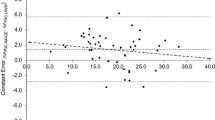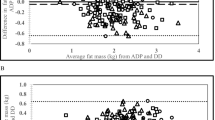Abstract
Background/objectives
Previous research has compared 2- and 3-compartment (2C and 3C, respectively) models against criterion 4-compartment (4C) models while utilizing the same body density (Db) method for all measures. This design induces an inherent bias and obscures the added benefit of a 3C model over the simpler 2-compartment (2C) models.
Purpose
The purpose of this study was to determine the effect of total body water estimates via single-frequency (SF-BIA) and multi-frequency (MF-BIA) bioimpedance analysis on body fat estimates derived from air displacement plethysmography (ADP)-derived 3C models.
Subjects/methods
A sample of 95 females and 82 males (n = 177) participated in this study. Underwater weighing, dual energy X-ray absorptiometry, and bioimpedance spectroscopy were used to calculate percent fat (%Fat) via a criterion 4C model (4CCRITERION). %Fat was predicted via 3CMFBIA (ADP and MF-BIA), 3CSFBIA (ADP and SF-BIA), and a stand-alone 2-compartment (2C) model, based upon ADP, when using Siri and Brozek body density conversion formulas (2CSIRI and 2CBROZEK. respectively).
Results
The standard error of estimate (SEE) was lowest for 3CSFBIA when evaluated in females and males (2.72% and 2.31%, respectively) and highest for 2CSIRI (3.98% and 3.84%, respectively). Similarly, the total error (TE) for females and males was lowest for 3CSFBIA (3.21% and 2.67%, respectively) and highest for 2CSIRI (4.58% and 4.48%, respectively) and 2CBROZEK (4.65% and 4.33%, respectively).
Conclusions
Results suggest that SF-BIA and MF-BIA can improve the estimation of %Fat, beyond simpler 2C models, when integrated with ADP in a more advanced 3C model. Furthermore, the present study revealed that 3CSFBIA was the best overall prediction model based upon TE values. The current study results support the integration of ADP and bioimpedance technology as part of a 3C model for the improvement of %Fat estimates over simpler 2C models.
This is a preview of subscription content, access via your institution
Access options
Subscribe to this journal
Receive 12 print issues and online access
$259.00 per year
only $21.58 per issue
Buy this article
- Purchase on Springer Link
- Instant access to full article PDF
Prices may be subject to local taxes which are calculated during checkout


Similar content being viewed by others
References
Wang ZM, Deurenberg P, Guo SS, Pietrobelli A, Wang J, Pierson RN, et al. Six-compartment body composition model: inter-method comparisons of total body fat measurement. Int J Obes Relat Metab Disord. 1998;22:329–37.
Wang ZM, Deurenberg P, Wang W, Pietrobelli A, Baumgartner RN, Heymsfield SB. Hydration of fat-free body mass: review and critique of a classic body-composition constant. Am J Clin Nutr. 1999;69:833–41.
Brozek J, Grande F, Anderson JT, Keys A. Densitometric analysis of body composition: revision of some quantitative assumptions. Ann N. Y Acad Sci. 1963;110:113–40.
Siri WE. Body composition from fluid spaces and density: analysis of methods. Tech Meas Body Composit. 1961;61:223–44.
Kerr A, Slater G, Byrne N, Chaseling J. Validation of Bioelectrical Impedance Spectroscopy to Measure Total Body Water in Resistance-Trained Males. Int J Sport Nutr Exerc Metab. 2015;25:494–503.
Nickerson B, Tinsley G. Utilization of BIA-derived bone mineral estimates exerts minimal impact on body fat estimates via multicompartment models in physically active adults. J Clin Densitom. 2018;21:541–9.
Alemán-Mateo H, Huerta RH, Esparza-Romero J, Méndez RO, Urquidez R, Valencia ME. Body composition by the four-compartment model: validity of the BOD POD for assessing body fat in Mexican elderly. Eur J Clin Nutr. 2007;61:830–6.
McLester CN, Nickerson BS, Kliszczewicz BM, McLester JR. Reliability and agreement of various InBody body composition analyzers as compared to dual-energy X-ray absorptiometry in healthy men and women. J Clin Densitom. 2020;23:443–50.
Gába A, Kapuš O, Cuberek R, Botek M. Comparison of multi- and single-frequency bioelectrical impedance analysis with dual-energy X-ray absorptiometry for assessment of body composition in post-menopausal women: effects of body mass index and accelerometer-determined physical activity. J Hum Nutr Diet. 2015;28:390–400.
Moon JR. Body composition in athletes and sports nutrition: an examination of the bioimpedance analysis technique. Eur J Clin Nutr. 2013;67:S54–9.
Nickerson BS, Esco MR, Bishop PA, Kliszczewicz BM, Williford HN, Park K-S, et al. Effects of heat exposure on body water assessed using single-frequency bioelectrical impedance analysis and bioimpedance spectroscopy. Int J Exerc Sci. 2017;10:1085–93.
Armstrong LE. Assessing hydration status: the elusive gold standard. J Am Coll Nutr. 2007;26 (sup5):575S–84S.
Armstrong LE, Maresh CM, Castellani JW, Bergeron MF, Kenefick RW, LaGasse KE, et al. Urinary indices of hydration status. Int J Sport Nutr. 1994;4:265–79.
Moon JR, Tobkin SE, Smith AE, Roberts MD, Ryan ED, Dalbo VJ, et al. Percent body fat estimations in college men using field and laboratory methods: a three-compartment model approach. Dyn Med. 2008;7:7.
Moon JR, Hull HR, Tobkin SE, Teramoto M, Karabulut M, Roberts MD, et al. Percent body fat estimations in college women using field and laboratory methods: a three-compartment model approach. J Int Soc Sports Nutr. 2007;4:16.
Heymsfield SB, Wang J, Heshka S, Kehayias JJ, Pierson RN. Dual-photon absorptiometry: comparison of bone mineral and soft tissue mass measurements in vivo with established methods. Am J Clin Nutr. 1989;49:1283–9.
Nana A, Slater GJ, Stewart AD, Burke LM. Methodology review: using dual-energy X-ray absorptiometry (DXA) for the assessment of body composition in athletes and active people. Int J Sport Nutr Exerc Metab. 2015;25:198–215.
Cole KS. Permeability and impermeability of cell membranes for ions. Cold Spring Harb Symp Quant Biol. 1940;8:110–22.
Hanai T. Electrical properties of emulsions. Emulsion Sci. 1968:354–477.
Moon JR, Tobkin SE, Roberts MD, Dalbo VJ, Kerksick CM, Bemben MG, et al. Total body water estimations in healthy men and women using bioimpedance spectroscopy: a deuterium oxide comparison. Nutr Metab (Lond). 2008;5:7.
Wang Z, Shen W, Withers RT. Human Body Composition-2nd Edn. Multicomponent molecular-level models of body composition analysis. Champaign, IL: Human Kinetics; 2005. p. 163–76.
Hopkins WG, Marshall SW, Batterham AM, Hanin J. Progressive statistics for studies in sports medicine and exercise science. Med Sci Sports Exerc. 2009;41:3–13.
Bland JM, Altman DG. Statistical methods for assessing agreement between two methods of clinical measurement. Lancet 1986;1:307–10.
Kendall KL, Fukuda DH, Hyde PN, Smith-Ryan AE, Moon JR, Stout JR. Estimating fat-free mass in elite-level male rowers: a four-compartment model validation of laboratory and field methods. J Sports Sci. 2016;35:1–10.
Moon JR, Eckerson JM, Tobkin SE, Smith AE, Lockwood CM, Walter AA, et al. Estimating body fat in NCAA Division I female athletes: a five-compartment model validation of laboratory methods. Eur J Appl Physiol. 2009;105:119–30.
Tinsley GM. Five-component model validation of reference, laboratory and field methods of body composition assessment. Br J Nutr. 2020;125:1–14.
Allen T, Krzywicki H, Roberts J. Density, fat, water and solids in freshly isolated tissues. J Appl Physiol. 1959;14:1005–8.
Modlesky CM, Cureton KJ, Lewis RD, Prior BM, Sloniger MA, Rowe DA. Density of the fat-free mass and estimates of body composition in male weight trainers. J Appl Physiol. 1996;80:2085–96.
Ortiz O, Russell M, Daley TL, Baumgartner RN, Waki M, Lichtman S, et al. Differences in skeletal muscle and bone mineral mass between black and white females and their relevance to estimates of body composition. Am J Clin Nutr. 1992;55:8–13.
Prior BM, Modlesky CM, Evans EM, Sloniger MA, Saunders MJ, Lewis RD, et al. Muscularity and the density of the fat-free mass in athletes. J Appl Physiol (1985). 2001;90:1523–31.
Tinsley GM, Graybeal AJ, Moore ML, Nickerson BS. Fat-free mass characteristics of muscular physique athletes. Med Sci Sports Exerc. 2019;51:193–201.
Nickerson BS, Tinsley GM, Fedewa MV, Esco MR. Fat-free mass characteristics of Hispanic adults: comparisons with non-Hispanic caucasians and cadaver reference values. Clin Nutr. 2020;39:3080–5.
Chumlea WC, Guo SS, Kuczmarski RJ, Flegal KM, Johnson CL, Heymsfield SB, et al. Body composition estimates from NHANES III bioelectrical impedance data. Int J Obes Relat Metab Disord. 2002;26:1596–609.
Dellinger JR, Johnson BA, Benavides ML, Moore ML, Stratton MT, Harty PS, et al. Agreement of bioelectrical resistance, reactance, and phase angle values from supine and standing bioimpedance analyzers. Physiol Meas. 2021 (Ahead of Print).
McCrory MA, Molé PA, Gomez TD, Dewey KG, Bernauer EM. Body composition by air-displacement plethysmography by using predicted and measured thoracic gas volumes. J Appl Physiol (1985). 1998;84:1475–9.
Demerath EW, Guo SS, Chumlea WC, Towne B, Roche AF, Siervogel RM. Comparison of percent body fat estimates using air displacement plethysmography and hydrodensitometry in adults and children. Int J Obes Relat Metab Disord. 2002;26:389–97.
Acknowledgements
The authors would like to acknowledge Gabriel L. Perez, Joshua Carrillo, Andres Orozco, Isabel Delgado, Noel Medrano, and Misael Duque for their efforts in the data collection of the current study. Results of the present study are presented clearly, honestly, and without fabrication, falsification, or inappropriate data manipulation. This study received funding support through the Texas A&M International University Quality Enhancement Plan.
Author information
Authors and Affiliations
Contributions
BSN wrote the manuscript with help from SVN, MIJ, and SAC. BSN and SAC conducted the study design. BSN and SVN assisted with all data collection. BSN and SAC completed statistical analysis. BSN, SVN, and MIJ designed figures and tables.
Corresponding author
Ethics declarations
Competing interests
The authors declare no competing interests.
Additional information
Publisher’s note Springer Nature remains neutral with regard to jurisdictional claims in published maps and institutional affiliations.
Rights and permissions
About this article
Cite this article
Nickerson, B.S., Narvaez, S.V., Juarez, M.I. et al. Effect of total body water estimates via bioimpedance on bod pod-based three-compartment body fat models. Eur J Clin Nutr 76, 581–587 (2022). https://doi.org/10.1038/s41430-021-00982-7
Received:
Revised:
Accepted:
Published:
Issue Date:
DOI: https://doi.org/10.1038/s41430-021-00982-7



